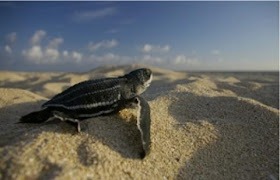 |
| Leatherback hatchling on nesting beach, St. Croix, USVI [Credit: Kelly Stewart] |
Thanks to a recent breakthrough in the genetics lab, Dutton and his colleagues have a clever way to find answers. Like detectives, they have learned that fingerprints help solve the puzzle…genetic fingerprints. For decades, most sea turtle studies and conservation efforts have focused on nesting females and hatchlings, because they're easiest for humans to access. Male sea turtles, which don't come ashore, are elusive characters.
Dutton's team has pioneered a technique that allows them to fill in the blanks using tiny DNA samples from nesting females and hatchlings. As Dutton and his colleague Dr. Kelly Stewart wrote in a recent article, Hidden in a hatchling's DNA is its entire family history, including who its mother is, who its father is, and to what nesting population it belongs.
This innovative tool is opening up new avenues in marine turtle conservation. Population recovery goals are based on how long turtles take to reach maturity, and genetic fingerprinting can help reveal this key piece of information, which may be different for each population. Dutton's team developed the technique while studying endangered leatherbacks on St. Croix, U.S. Virgin Islands. In the last four years, they have sampled 20,353 hatchlings there, and discovered the genetic identity of the fathers, even when multiple males have sired a single clutch of eggs; how often individual turtles mate and their reproductive success; and the ratio of males to females among the breeding turtles.
On Padre Island National Seashore in Texas, critically endangered Kemp's ridley turtles have been leaving scattered nests along remote beaches, but females are often long gone by the time monitors find the nests. There, NOAA's Southwest Fisheries Science Center and the National Park Service are using the technique to match mystery nests to mother turtles. Identifying who's nesting where and when, survival rate, and breeding success over many years will help us monitor this small population and gauge the impact of major events like disasters.
In the most surprising news yet, green turtles have begun nesting in the main Hawai'ian islands for the first time in generations. Green turtles, or honu, have nested in the remote Northwest Hawai'ian Islands, primarily on the quiet, low-lying beaches of French Frigate Shoals, a coral atoll about 500 miles from Honolulu.
Genetic fingerprinting shows that about 15 untagged females have become "founders" on the main Hawai'ian islands, boldly nesting where no one has nested before…at least not for hundreds of years. It's possible that this pioneer population could provide a kind of buffer as sea level rise threatens to shrink their traditional nesting beaches. Many questions remain, but for now science is giving turtles, and those who care about them, reason to hope.

No comments:
Post a Comment